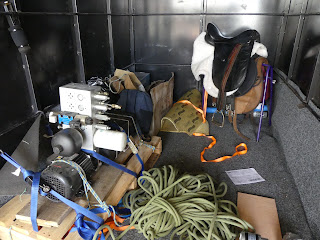Thinking about the sub-systems required for the riding simulator
Making a complete and high-fidelity horse riding simulator is not going to be simple. It will require a number of sub-systems to function. But more importantly, it needs to be broken down into sub-systems, so that it can be developed by a community simultaneously, without everyone treading on each others toes. It is also important for ensuring that each sub-system can be tested independently, and if we do it right, can also be put under an automatic test and continuous integration regime, so that the correct system-level behaviour can be obtained as quickly and easily as possible. I'll talk more about this "systems engineering" like approach later. For now, I just want to note down the key sub-systems that will be required:
1. Physical Structure - i.e., the structure that will function as the horse's body, and to support the body.
2. Sensors -- i.e., the components that will allow the horse to measure the rider's position and interactions, such as pressure applied on some part of the horse by the rider.
3. Sensation to Rider Intention -- i.e., the software that will convert sensor readings into rider intentions. This will convert the sensor readings into estimates of the "aids" that those readings suggest the rider is attempting to apply to control the horse.
4. Sensation and Rider Intention to Horse Intention and Action -- i.e., the software that simulates the horse's brain, allowing it to react to the sensations it is receiving, both at a raw level, and also as digested into rider intentions.
5. Horse Action to Movement Scheduling -- i.e., the conversion of horse actions into a sequence of movements that create the sensation in the rider of the horse having carried out those actions. This will result in a schedule of movements to be fed to the actuators.
6. Horse Actuators -- i.e., the components that enable the horse body to move.
7. Simulated Environment -- i.e., the 3D virtual environment in which the horse will be placed and act. This will also be used to generate and feed the 3D virtual reality perspective to the rider.
8. Auxilliary Environment Actuators -- Components that are used to supplement the Virtual Reality audio/video environment for the rider. This might include things like directional fans, that can create the sensation of wind rushing past the rider as they ride at speed, or are simply in a windy environment.
There are probably other sub-systems that will become apparent as we progress, but these provide a good starting point for me to work from, to create a simulated horse that can move in both the real and virtual worlds in an authentic and convincing manner.


Comments
Post a Comment